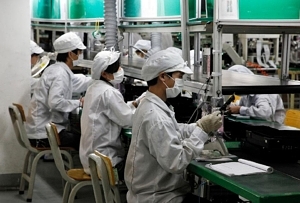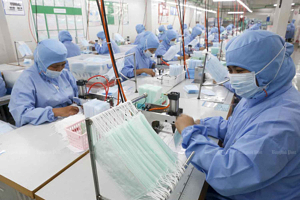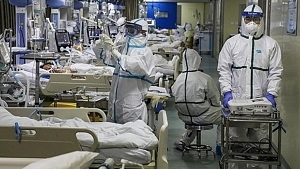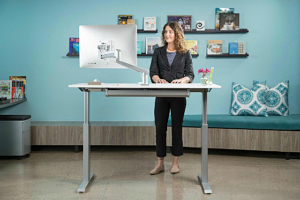COVID-19’s Dramatic Impact on the Office Fitness Industry, and Standing Desk Suppliers in Particular
Like most reviews sites, our editorial staff and laboratory testing expenses are partially offset by earning small commissions (at no cost to you) when you purchase something through those links. Learn More

[Also see our recent article on Can Standing Desks Really Slow Down the Spread of the Coronavirus?]
Many industries are being heavily affected by the spread of the coronavirus, some worse than others. Certainly travel, hospitality, tech, energy and retail are going be taking some of the hardest hits as public health officials predict that 40%–70% of the global population will eventually catch the virus. It has been three weeks since the World Health Organization declared the Novel Coronavirus 2019 (“COVID-19”) a worldwide pandemic, with over half a million cases and climbing fast.
For the “office fitness” industry—manufacturers of standing desks, treadmill desks, sit-stand converters, ergonomic accessories, etc.—it’s a mixed bag. In this article we examine the impact on both the supply side and demand side of this multi-billion dollar market segment.
By definition, the office fitness sector lives at the intersection of office furniture and fitness equipment, but in all practicality it is comprised 95% of furniture and 5% of things like office treadmills and under-desk cycles. As the office furniture industry goes (a $46B industry in the USA alone), this is bifurcated between the traditional commercial contract industry with players like Herman Miller and Steelcase comprising about 40% of the marketing, and the retail industry with players like Amazon, IKEA, Staples and many of the smaller companies whose products we review here comprising the other 60%. That ratio has just tilted heavily over to retail and e-commerce with Covid19, at least temporarily.
The commercial contract furniture companies’ stocks have been hammered as badly as airlines and hospitality stocks. The difference being there’ll be no bailouts for the furniture industry. Analysts know that no one is thinking about office expansions and major remodeling projects right now. Employers are focused on getting their workers to be productive at home for at least the next few months. This has been a boon for e-commerce sellers who are seeing multiples of their ordinary sales levels for this time of year. There are always going to be winners and losers at times like this.
Supply Side Impact
 Over the past couple of months we’ve interviewed top executives of many leading suppliers of OEM components and finished products, from linear actuator manufacturers to monitor arm producers, all across the globe. Factories in China have slowly been restoring production capacity, and while verifiable facts are hard to come by it seems that a relative few are back at full capacity at this time. All of these factories are buried in backorders not just from the Chinese New Year but the many weeks after in which most workers were unable to get transportation back to their factories.
Over the past couple of months we’ve interviewed top executives of many leading suppliers of OEM components and finished products, from linear actuator manufacturers to monitor arm producers, all across the globe. Factories in China have slowly been restoring production capacity, and while verifiable facts are hard to come by it seems that a relative few are back at full capacity at this time. All of these factories are buried in backorders not just from the Chinese New Year but the many weeks after in which most workers were unable to get transportation back to their factories.
The supply chain issues run very deep. Even if a factory could order steel, wood, plastic, precious metals, and other raw materials, getting timely and affordable transportation for those materials is still challenging, and getting enough workers to assemble finished products is still a hurdle for most factories. Most of what is being produced at the moment is from stockpiled materials, which will eventually run out, as will inventories at Amazon and other warehouses in the US. Then there are the issues surrounding getting finished products to the shipping ports, and getting passage on a container ship.
Some factories that have been unable to get enough of their original workers back in have resorted to hiring and training new employees from closer environs, but this strategy has its own challenges. In particular, quality assurance is going to take a hit as these workers come up to speed.
 Every factory in China that we spoke with has been grappling with passing a government audit for how they will handle quarantining employees suspected of infection. Face masks are still hard to come by and price gouging is now rampant worldwide for these simple devices.
Every factory in China that we spoke with has been grappling with passing a government audit for how they will handle quarantining employees suspected of infection. Face masks are still hard to come by and price gouging is now rampant worldwide for these simple devices.
American manufacturers are not immune to any of this as, for all intents and purposes, there almost isn’t such a thing as a purely made-in-USA technology product anymore. Companies that manufacture monitor arms in Michigan or Pennsylvania still source commodity components, such as the all-important cylinder poles, from Chinese factories. We saw this play out before, in October 2018 when the first tariff passed. US manufacturers that didn’t hoard overseas components prior to the tariff’s starting date were unable to ship their made-in-America products. This was followed by massive delays coming through US shipping ports, seeing container ships anchored outside the harbors for weeks, unable to unload their goods and head back to China.
Those factories that do not go under will still endure months of delays in getting back to full production capacity and fulfilling backorders. Historical choke points have been the first few weeks after Chinese New Year and the months leading up to peak retail in the US, i.e. early fall when Christmas inventories are jamming up the cargo ports. And so we are set up for another perfect storm. In the months between now and August/September, while factories are slowly recovering in China, and finding new suppliers for those that could not survive the gap, our ports will already be jammed with toys, phones, and yes, standing desks coming in from China, but will also be dealing with the influx of products backordered since February.
There could be mayhem, but there will certainly be increased costs of international shipping. With the massive wind-down of passenger airliners that ordinarily carry a lot of cargo freight in their bellies, the costs of air freighting has gone through the roof as passenger aircraft are being converted to cargo planes.
What all this means to American consumers
First and foremost, American consumers will start seeing many products, not just face masks, either out of stock or priced with outrageous markups as inventories near depletion in US warehouses. Many consumers do not realize how many of the products they use every day come from China, or use Chinese-sourced raw materials or components. We’re already seeing significant shortages on just about every office fitness e-commerce retailer that sources their desks from China.
The office fitness industry is extremely reliant on Chinese suppliers, especially in the categories of standing desk converters, commodity standing desks under $600, monitor arms, standing mats, office treadmills, and active seating. We are already hearing from some US resellers of Chinese made products that inventories are depleting rapidly.
Some are discounting heavily, as much as 20%, in order to attract customers willing to live with a 4-8 week backorder on their desks. Others are simply de-listing their out-of-stock items and pushing what they have left to sell. The problem is that most customers right now are too impatient to wait that long just to save $100 on a desk, their backs are already hurting from working long hours on the couch or at the kitchen counter.
Not only are certain finished products vulnerable to shortages, spare parts may be heavily impacted as well. If a Chinese-made standing desk arrives with a failed lifting column (perhaps built by a newly-trained worker under tremendous strain to meet production quotas) it may be a long time before a replacement leg could be sent out by the seller. Hassles like this will likely become more common than usual with Chinese-made desks.
There was already a big difference in quality expectations, warranty coverage, customer service experiences and product performance between commodity brands that use Jiecang and other Chinese componentry, and those made in the USA using domestic componentry. Our primer on The Differences Between Chinese-Made and American-Made Standing Desks goes into more depth on those issues, which now will only be exacerbated.
These new issues sparked by the coronavirus pandemic are not likely to improve matters. If anything, the situation will likely result in a narrowing of price differences between brands like UpLift, Fully, GeekDesk and Evodesk—that are built on Chinese frames—and makers like iMovR and Humanscale that make all their desk components in the USA. It’s a double whammy for sellers that have already been absorbing 25% tariffs on these products. Many US marketers have already been switching supply lines from China over to Taiwan, South Korea, Vietnam, Thailand and other Asian countries to get around the trade war tariffs, but as some of these countries start grappling with outbreaks these factories may be challenged as well.

Based on our conversations with factories from China to the US to Scandinavia, we’re concerned that many suppliers will go out of business before the calamity is over. Certainly for the next few months many consumers and businesses will need to turn to domestic suppliers and pay a little more for their active workstation furniture and accessories. Long-term ramifications are harder to predict from today’s vantage point.
Clearly the winners in this tectonic marketplace shift have been those few online sellers that build their standing desks entirely in the USA, such as iMovR, who also report to us that they’re hearing a lot more customer sentiment expressed lately about preference for American made products, and specifically against products made in China.
Demand Side Impact
With schools remaining shut likely through the end of this school year in most of the country, and millions on unemployment, some 100 million office workers are relegated to finding a way to work productively from home. Now is a good time for everyone to think about their home office setups. Many productivity pundits are calling out the silver lining in all this, that countless employers are discovering the many benefits of having a remote work force. They’re figuring out how to use Zoom, Slack and other tools to keep their teams working collaboratively.
If knowledge workers (those who spend the majority of their day at a computer) are going to be working from home a lot more in the future they may want to invest in, or get their employers to fund, a standing desk or treadmill desk for their home office. In fact since early March the standing desk business in particular is experienced the greatest surge in demand that it has ever seen, nearly entirely on the e-commerce side. Meanwhile the pipeline or major projects for the commercial contract furniture sellers has been emptying out rapidly.
 So, like we said at the beginning, it’s a mixed bag of good fortune and misfortune for companies in the office fitness industry, and office furniture industry in general. We expect some contraction in the industry as smaller and more volatile producers and sellers crumple, to be followed by more merger and acquisition activity afterwards as many will sell or combine their businesses to avoid bankruptcy.
So, like we said at the beginning, it’s a mixed bag of good fortune and misfortune for companies in the office fitness industry, and office furniture industry in general. We expect some contraction in the industry as smaller and more volatile producers and sellers crumple, to be followed by more merger and acquisition activity afterwards as many will sell or combine their businesses to avoid bankruptcy.
It’s not entirely clear yet who all the winners and losers will be when this calamity is over, but in conversations with factories around the world our sense is that the long-time US and Scandinavian vendors are relishing the likely winnowing of Asian competition, while scrambling to maintain fat inventories of what may become hard-to-get parts.
We have seen Chinese component suppliers putting out dire email communications to their OEM customers about their new challenges. We read one which started out with “the good news is none of our employees have been infected,” and then went on to explain their challenges in getting steel, paint, motors and other key raw materials and components, not to mention getting 70+% of their employees back to work.
Also on the plus side road traffic has all but disappeared, and the air we breath is cleaner for it. There is likely going to be a decades-long impact on how companies deploy their human resources, all as a result of this viral pandemic. And that impact will be felt globally.
We’ll keep updating this article as the situation evolves. Stay tuned by subscribing to our free newsletter.

0 Comments
Leave a response >